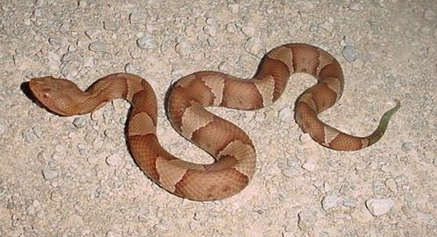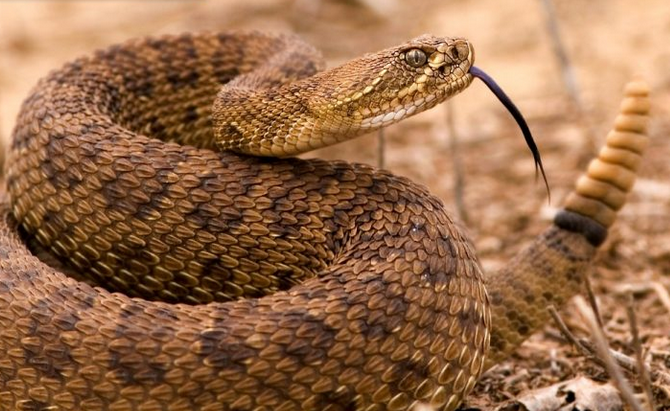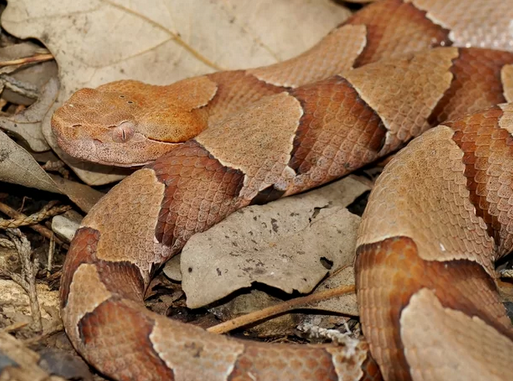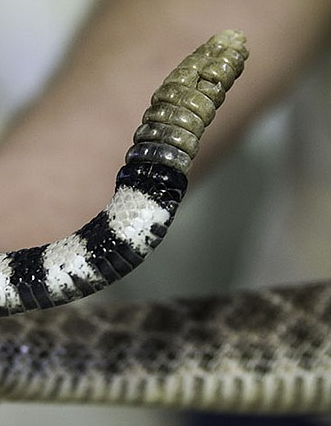Thursday, August 08 2019
The odds of the “average” person being bitten by a rattlesnake is low— that is, if you’re an “average” city dweller or someone who doesn’t hike, hunt, or work around timber. But what if you spend a great deal of time outdoors in known snake country either working or playing or both? Then you might want to take the threat of snakebite seriously and protect yourself with rattlesnake gaiters or by wearing snake proof boots. The Centers for Disease Control and Prevention report that 7,000 - 8,000 venomous snakebites occur per year in the United States. If you like statistics, here are a few more:
• 55% of people bitten by snakes are male, ages 17 to 27.
• 28% of snakebite victims were intoxicated.
• 50% of bites occur on the feet and legs; 50% are to the fingers and hands.
• 57% of snakebite victims were handling the snake at the time of the bite.
A triangular shaped head and cat-like eyes are  giveaways that a snake is venomous. Non-venomous snakes have round heads and round pupils. Venomous snakes will normally be heavier and fatter, too. The Western Diamondback, also called the Pacific Western Rattlesnake, is one of the most common member of the viper family. A common myth about any species of rattlesnake is that they are vicious and go around looking for someone to bite. The fact is that most actually only strike in self-defense or to obtain food. Self-defense includes when they are startled, and that’s exactly when the “average” person is bitten— when they accidentally step on or near a viper, or are working in tall weeds or around wood piles. When not basking out in the sun, most of a snake’s time is spent hiding under a rock or a bush. If you have ever hiked through the woods, chances are you have passed within a foot or so from a rattler and luckily never knew it. giveaways that a snake is venomous. Non-venomous snakes have round heads and round pupils. Venomous snakes will normally be heavier and fatter, too. The Western Diamondback, also called the Pacific Western Rattlesnake, is one of the most common member of the viper family. A common myth about any species of rattlesnake is that they are vicious and go around looking for someone to bite. The fact is that most actually only strike in self-defense or to obtain food. Self-defense includes when they are startled, and that’s exactly when the “average” person is bitten— when they accidentally step on or near a viper, or are working in tall weeds or around wood piles. When not basking out in the sun, most of a snake’s time is spent hiding under a rock or a bush. If you have ever hiked through the woods, chances are you have passed within a foot or so from a rattler and luckily never knew it.
Make no mistake, a bite from a rattler (or copperhead or water moccasin, etc.) can be very serious business. Their venom breaks down the tissue around the bite. When a rattlesnake bites its prey, this action of breaking down the tissue hastens the digestive process and makes it easier for the snake to swallow its prey. If a human is bitten, there is often a loss of tissue around the bite. The snake’s teeth also transfer bacteria and the venom suppresses the immune system of the victim, making it tougher to fight off infection. While this rarely causes death, it can result in the loss of a limb. And the entire process is extremely painful and can be expensive due to the cost of anti-venom.
So why take a chance? If you spend a good amount of time where snakes live, protect yourself by wearing snake proof gaiters or snake proof boots. Luckily, Razer snake gaiters for women and snake gaiters for men are the same product. Children are bitten more frequently than adults. Most children are bitten because they often go barefoot or actually pick up a rattlesnake out of curiosity. Make sure the kids are wearing snake chaps sized just for them.
And if you are bitten, keep in mind that all that stuff about tourniquets, cutting open bites, or trying to suck out the venom has been disavowed by current medical thinking. Don’t apply ice to the wound either. Instead, the advice is simply to seek medical treatment immediately. If you’re a long way from that, try to keep your heart rate down and the bite location below the level of your heart. Your best snakebite kit is your cellphone or your car keys! And although it might be counter-intuitive, avoid killing snakes since they are valuable to our ecosystem. Plus, in many states, illegally killing a snake is a misdemeanor punishable by a fine and/or jail time.
Tuesday, June 25 2019
 The U.S. Centers for Disease Control estimates that 7,000-8,000 people are bitten by venomous snakes annually and that a small number of those victims die. Most snake bite deaths occur in children, the elderly, or with people who do not seek medical attention. While most bites are not fatal if treated by medical professionals, getting bitten is still the stuff of nightmares— swelling and discoloration of the surrounding tissue, intense pain, itching, nausea, rapid pulse, loss of muscle coordination and weakness, not to mention the cost of antivenom. Areas around the bite may suffer tissue death. It is not uncommon for victims bitten on the fingers and toes to have them amputated. The venom of a rattlesnake is primarily a hemotoxin, meaning that it works on the blood by destroying red blood cells and disrupting coagulation. It has the potential to cause organ degeneration and generalized tissue damage. Victims of venomous bites typically show signs of envenomation within 30 to 60 minutes. It’s crucial to get to a hospital immediately! While this information should be taken seriously, it is not meant to scare anyone away from enjoying the great outdoors, rather it's a reminder of what to do if you encounter a snake. The U.S. Centers for Disease Control estimates that 7,000-8,000 people are bitten by venomous snakes annually and that a small number of those victims die. Most snake bite deaths occur in children, the elderly, or with people who do not seek medical attention. While most bites are not fatal if treated by medical professionals, getting bitten is still the stuff of nightmares— swelling and discoloration of the surrounding tissue, intense pain, itching, nausea, rapid pulse, loss of muscle coordination and weakness, not to mention the cost of antivenom. Areas around the bite may suffer tissue death. It is not uncommon for victims bitten on the fingers and toes to have them amputated. The venom of a rattlesnake is primarily a hemotoxin, meaning that it works on the blood by destroying red blood cells and disrupting coagulation. It has the potential to cause organ degeneration and generalized tissue damage. Victims of venomous bites typically show signs of envenomation within 30 to 60 minutes. It’s crucial to get to a hospital immediately! While this information should be taken seriously, it is not meant to scare anyone away from enjoying the great outdoors, rather it's a reminder of what to do if you encounter a snake.
First, assume all snakes are venomous and leave them alone. Depending on the state you live in, there are many species of rattlesnakes— timber, prairie, canebrake, diamondback, and many others. The greatest concentration is found in the Southwestern United States and in Northern Mexico. For example, Arizona is home to 13 species of rattler, more than any other state. These snakes are commonly called pit vipers. The "pit" is an extremely sensitive organ located between the snake's eye and nostril on both sides of its head. These pits are so sensitive that the snake can detect the body temperature of a mouse, and judge its distance— whether that be a few inches or as far away as two feet. All snakes have an electrostatic sensor connected to its tongue that allows it to "taste" or chemically sense the air around it. Snakes are extremely attune to vibrations in the ground, too, so hiking with a stick or pole is a good way to “warn” snakes something is moving their way. Most pit vipers have tails with a series of rattles, hence the name rattlesnake. When rattlesnakes are disturbed, the rapid vibration of their tails will make a characteristic rattling sound to warn the intruder of their presence. However, not all rattlesnakes will “rattle” when disturbed. For this reason, when you are in rattlesnake country, pay close attention to where you walk, sit and place your hands. Wear snake gaiters or snake boots to protect your lower legs.
All venomous snakebites should be considered life-threatening.When someone has been bitten by a venomous snake, time is of the essence. Get medical help immediately! If possible, call ahead to the emergency room so antivenom can be ready when the victim arrives. Until then, keep the victim calm, restrict movement and keep the affected area below heart level to reduce the flow of venom. Wash the bite area with soap and water. Remove any rings or constricting items, as the affected area will swell. Do not apply a tourniquet, cut into the bite or try to suction out the venom, as doing so may cause more harm than good.
While no one wants to encounter a snake, keep in mind they occupy a valuable place in our ecosystem and should not be killed upon sight. They help reduce rodent populations, which destroy crops and sometimes carry diseases which can infect people. In general, snakes don't purposefully position themselves to frighten people. They'd much rather avoid encounters and usually will flee. There is no good reason to kill a snake except in the situation of a venomous snake posing immediate danger to people or pets. Snakes usually bite people only if they are molested on purpose or startled by accident; it's their only means of self-defense. Get outside this summer and have fun! Being in snake country is nothing to worry about if you take sensible precautions. Please stay alert and appreciate snakes as an integral part of wildlife.
Sunday, April 28 2019
Did you know? Copperhead mating season lasts from February to May and from late August to October. This means that rising temperatures coupled with mating season leads to more and more snake sightings. In fact, the number of urban sightings this April was overall higher than this time last year. Copperhead snakes are some of the more commonly seen North American snakes. They're also the  most likely to bite. Copperhead snakes are found from southern New England to West Texas and northern Mexico: Texas, Oklahoma, Kansas, Missouri, Arkansas, Louisiana, Mississippi, Alabama, Georgia, Florida, South Carolina, North Carolina, Tennessee, Kentucky, Virginia, Illinois, Indiana, Ohio, Iowa, Pennsylvania, Maryland, New Jersey, Delaware, New York, Connecticut, and Massachusetts. Copperheads will be a little bit more territorial now because they are trying to mate. And keep in mind that the venom of juvenile copperheads is just as potent as an adult’s. most likely to bite. Copperhead snakes are found from southern New England to West Texas and northern Mexico: Texas, Oklahoma, Kansas, Missouri, Arkansas, Louisiana, Mississippi, Alabama, Georgia, Florida, South Carolina, North Carolina, Tennessee, Kentucky, Virginia, Illinois, Indiana, Ohio, Iowa, Pennsylvania, Maryland, New Jersey, Delaware, New York, Connecticut, and Massachusetts. Copperheads will be a little bit more territorial now because they are trying to mate. And keep in mind that the venom of juvenile copperheads is just as potent as an adult’s.
Copperheads reside in an extremely wide range of habitats and are quite tolerant of “habitat alteration." This means that they can survive well in suburban areas. Copperheads can sometimes be found in wood and sawdust piles, abandoned farm buildings, junkyards and old construction areas. They often seek shelter under surface cover such as boards, sheet metal, logs or large flat rocks. Since they can live just about anywhere, copperheads bite more people than any other U.S. snake species, according to the North Carolina Cooperative Extension at North Carolina State University. But their venom is mild and rarely fatal. Generally, rattlesnakes are considered the most venomous and the most likely to cause death.
Copperheads are pit vipers, like rattlesnakes and water moccasins. Pit vipers have heat-sensory pits between eye and nostril on each side of head which are able to detect minute differences in temperatures so that the snakes can accurately strike the source of heat, which is often potential prey. Copperhead behavior is very much like that of most other pit vipers— they are generally docile outside of mating season. They would much rather lay motionless and let you just walk on by. Most strikes result from a defensive reaction to being stepped on or startled.
Keep in mind that snakes of many species are through hunkering down now that the weather is warmer, making human encounters more likely with ALL snakes. With extensive urbanization and encroachment of housing developments into the natural habitats of snakes and other reptiles, children playing outdoors are at greater risk for encountering a snake and consequently suffering a snakebite. More than 1,300 U.S. kids suffer bites each year on average, with one in four attacks occurring in Florida and Texas, a new study reveals. All 50 states and Washington, D.C., reported snakebites to children and about one-fifth of these bites required admission to an intensive care unit, researchers found. Snake Chaps for Kids should be considered, along with snake proof boots or snake gaiters for adults if your family is active outdoors. Experts also recommend keeping dogs leashed instead of allowing them to roam free. Dogs are at increased risk of being bitten due to holding their nose to the ground while investigating the outdoors. Speak to your veterinarian about canine rattlesnake vaccines and what to do if your pet is bitten.
Although you shouldn’t let the fear of snakes keep you from enjoying the great outdoors, play it safe. Be alert and stick to well-used trails and avoid tall grass, weeds and heavy underbrush where snakes may hide during the day. Fish and Wildlife experts recommend knowing what to do in the event of a snake strike.
• Stay calm and seek medical care immediately.
• Do not apply ice or a tourniquet.
• Do not try to suck out the venom, take aspirin or ibuprofen or try home remedies.
• Remove watches, rings, etc., which may constrict swelling
Tuesday, May 01 2018
As many areas of the country settle into warmer temperatures, especially in the desert regions, snakes are slith ering out of their dens and becoming increasingly more active. Once temperatures begin to hit 75 degrees, snake season begins. But that’s not all… it’s also time for the inevitable emergence of spiders and scorpions, too! Yikes! But that doesn’t mean we should avoid the great outdoors and stay home. It just means to take common sense precautions and be aware of your surroundings. ering out of their dens and becoming increasingly more active. Once temperatures begin to hit 75 degrees, snake season begins. But that’s not all… it’s also time for the inevitable emergence of spiders and scorpions, too! Yikes! But that doesn’t mean we should avoid the great outdoors and stay home. It just means to take common sense precautions and be aware of your surroundings.
One of the best ways to avoid being bitten by a snake is to think about where you put your hands and feet. Look carefully before moving rocks or any object that may be providing shade for a snake. Use caution when walking through fields with tall grass, or along rivers or creeks. Keep in mind snakes are more active in the cooler hours of the day, which means they are more active at night through early morning, so consider installing outdoor lighting fixtures along porches and sidewalks, and carry a flashlight after dark. If you have a backyard swimming pool with a messy log pile next to it and dog food lying out, then you've created the perfect environment to invite rodents, which invites snakes.
Some regions that received more rain than usual this year during the cooler months means there is plenty of spring vegetation to feed the rodents and birds that rattlesnakes love to eat. When the ecosystem flourishes, the animal flourishes, and a number of those birds and rodents are prey to venomous snakes such as rattlesnakes. But that doesn't mean more rattlesnakes now, experts say. That may happen in a couple years, but not until rattlesnakes get fat and happy from plentiful food and make more baby rattlesnakes. As the weather gets warmer, we see snakes come out to sun themselves and look for food, but that doesn’t necessarily mean there are MORE snakes than previous years, spring just means all snakes become more active and are therefore seen more often.
Nearly all rattlesnake bites result from human error, not rattlesnake aggression. It’s no surprise that the stereotypical bite happens to a male ages 17 to 27 with large amounts of alcohol involved! All rattlesnakes can be aggressive at certain times, but not all rattlesnakes are aggressive in general. Some don’t possess their iconic “rattle” but it’s best to assume all snakes are venomous. Although new species of rattlesnakes continue to be discovered, there are currently about 20 species in the United States (13 of those are found in Arizona). The most commonly encountered is the western diamondback; it accounts for the most bites and deaths. They are not aggressive; they're defensive. If you see any type of rattlesnake, don't make it feel threatened and leave a lot of room between you and the snake.
If you are bitten by a rattlesnake or other venomous snake the Mayo Clinic lists these steps:
• Call 911
• Remain calm and move beyond the snake's striking distance.
• Remove jewelry and tight clothing before you start to swell.
• Position yourself, if possible, so that the bite is at or below the level of your heart.
• Clean the wound, but don't flush it with water. Cover it with a clean, dry dressing.
Be sure not to to do these things:
• Don't use a tourniquet or apply ice.
• Don't cut the wound or attempt to remove the venom.
• Don't drink caffeine or alcohol, which could speed your body's absorption of venom.
• Don't try to capture the snake. Try to remember its color and shape so that you can describe it, which will help in your treatment.
Of course your best defense against venomous snakes is not to take a chance in the first place. Adults can wear snake bite protection such as lower leg snake gaiters or full chaps or snake proof boots when working or playing in snake country. Snake chaps for children also available. Be safe and have fun!
|